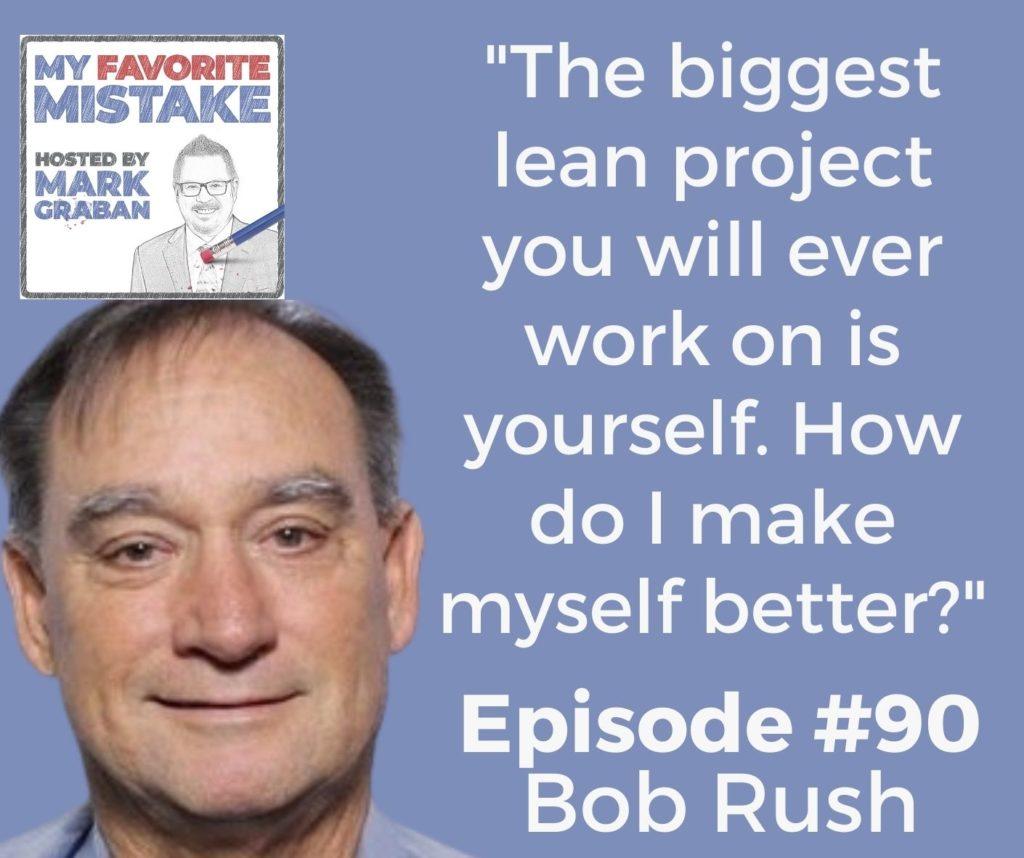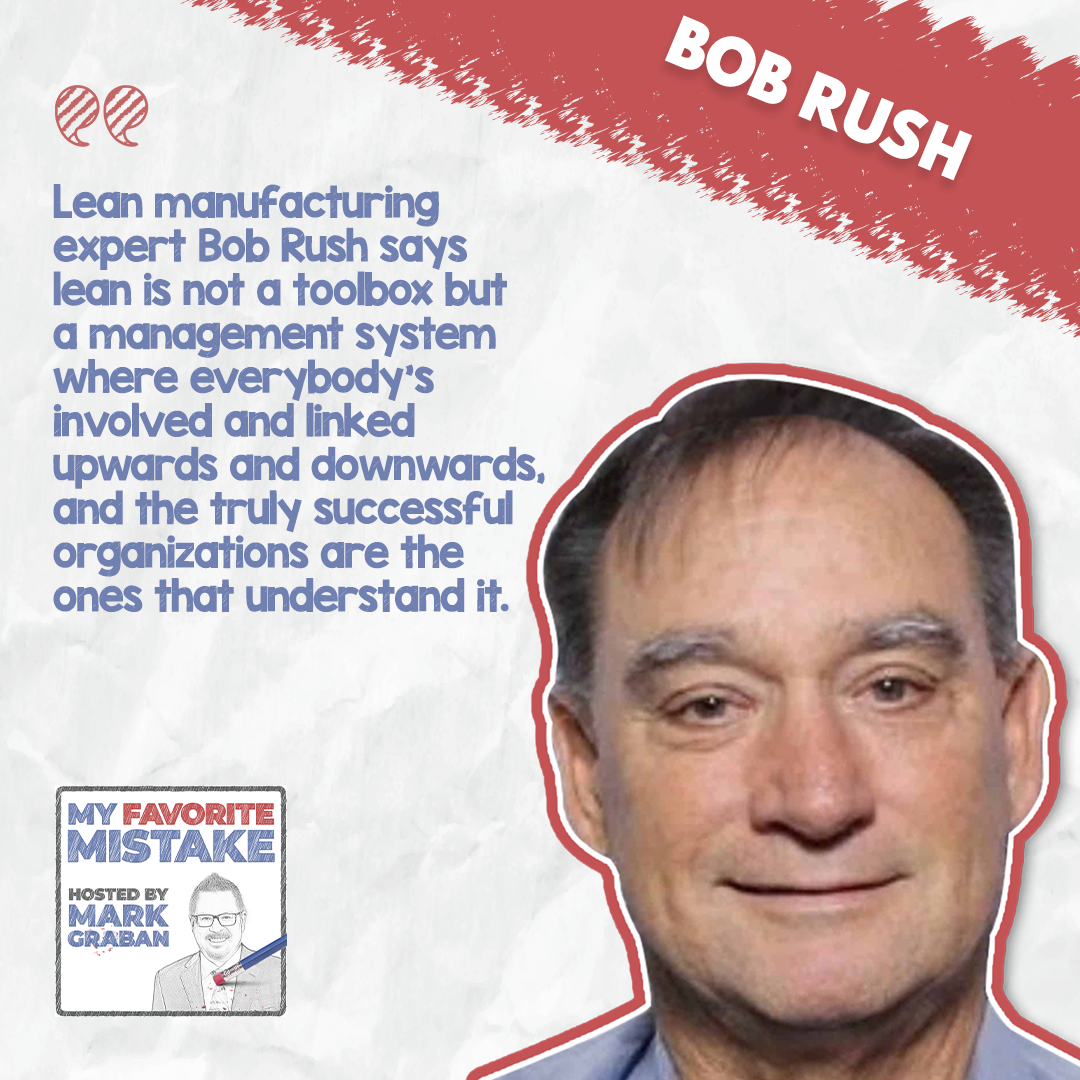Listen:
Check out all episodes on the My Favorite Mistake main page.
My guest for Episode #90 of the My Favorite Mistake podcast is my friend Bob Rush, a Lean manufacturing expert, a management consultant (Bob Rush Consulting), and a contributor to the anthology book Practicing Lean that I published a few years ago.
His bio from his chapter read: “Bob has over 35 years of operations experience and has had over 25 years of Lean practice. His experience is in companies ranging from startups to Fortune 100 companies, and title levels that ranged from shipping clerk to VP of operations. Some of the companies he has worked with, and for, include Hewlett Packard, JDS Uniphase, and Idex Corporation. His journey includes ten years of consulting experience, where he had only himself to blame if things didn’t work out.” Bob was also “associate Lean manager” at Tesla Motors from 2015 to 2018 before returning to consulting.
In today's episode, Bob shares his “favorite mistake” story about not realizing, at first, that “Lean” is a system, not a toolbox. Why does he say that “the biggest project I’ll ever work on is myself”?
Questions and Topics:
- What’s your elevator speech about Lean? How do you explain it to a CEO?
- Creating a culture where it’s OK to talk about mistakes?
- What was the teaching style of your mentors? They knew you’d figure it out? Not simple telling…
- “Big fan of making mistakes” – Why did he once give a reward for the biggest mistake?
- Find Bob on
Quotes:

Subscribe, Follow, Support, Rate, and Review!
Please follow, rate, and review via Apple Podcasts or Podchaser or your favorite app — that helps others find this content and you'll be sure to get future episodes as they are released weekly. You can also become a financial supporter of the show through Anchor.fm.
You can now sign up to get new episodes via email, to make sure you don't miss an episode.
This podcast is part of the Lean Communicators network.

Other Ways to Subscribe or Follow — Apps & Email
Lean Manufacturing Expert Bob Rush Is “A Big Fan Of Mistakes”

We’re joined by a friend of mine. I’m happy that Bob Rush is here. He is in management consulting with his firm Bob Rush Consulting. He has a long history. I respect Bob’s experience in the manufacturing world. We’ve got similar professional backgrounds and experiences. Bob was also one of the contributors like Jamie Parker, who was in Episode 8 of the show. Bob was a contributor to our book, Practicing Lean. With that, Bob, thank you so much for being here. How are you?
I’m good. Glad to be here. Glad to be anywhere nowadays.
I’m glad that we’re doing an episode. I’ve asked Bob a number of times over the years, so I’m glad you finally said yes. I hope this ends up, I don’t think it’ll be a mistake.
I don’t think so. It may be on your part but not mine.
I’m not expecting that at all. We’re going to be able to delve into all kinds of different topics around workplace culture, mistakes, and learning. As we always do here, Bob, I’ll tee you up to tell your story. What is your favorite mistake?
I’m going to tell a little bit of a story and you’ve heard part of it. I discovered Lean by accident. I had a client that sent me to Boeing to learn about Lean from Shingijutsu. I did a Kaizen event and started working with it and picked it up along the way. I picked up a sensei who taught me the ins and outs of it. He taught me more than I knew and it took me a while to realize it.
My favorite mistake is I didn’t realize that Lean is a system. It’s not a toolbox. Although, there is a toolbox to it. It’s a system. It’s a management system and I didn’t realize that. The day I discovered it, I had an epiphany, and my sensei, although he claimed not to speak English, every now and then would slip up and speak in pretty good English. Through the interpreter, he explained very graciously that he knew I would figure it out like that.
Later the interpreter pulled me to that side and said that my sensei said, “I thought he’d get it a lot sooner than he did.” Once you start thinking like that, it opens up everything. You realize that this is a different world than what you’re used to. I tell everybody that I served in Vietnam and I discovered Buddhism in Vietnam.
When I came home, I was fortunate enough to link up with a Zen master who was also an Army veteran. We met through the VA and he got me started on Zen. I had this background and Lean is an exercise and Zen existence. It’s about the here and now. It’s about the old saying, “Good enough rarely is wrong. Good enough is good now. It won’t be good enough tomorrow maybe but it’s good enough now.”
As long as I fix something, then it’s good enough and I’ll keep working on it. Once I realized that, it took over and expanded. I told you that I’m mentoring a guy here in town in Murfreesboro. I challenge people that want me to mentor them. For one, it’s a two-way street, so I want to make sure that they understand that. He’d ask questions and I’d always give him an assignment to go away, “Tell me about this. Tell me about that.” One of my favorite challenges for people is, “Tell me about the biggest project you’ve ever worked on.”
Everybody, except him, brought me data from their project. “I did a Kaizen on this. I did a SMED event and did this.” He came back and he says, “This is probably the wrong answer but the biggest project I’ll ever work on is myself.” He is correct. The biggest Lean project you will ever work on is yourself. How do I make myself better? How do I make myself more customer-centric? He is learning about Lean as a system.
[bctt tweet=”The biggest lean project you will ever work on is yourself. How do I make myself better?” via=”no”]
Originally, he started out with specific questions about tools. You can build a knowledge of tools and probably not get the essence of Lean. You need to understand it as a system and it’s a management system. This is not a little operational system somewhere. Everybody’s involved in it. Everybody’s linked upwards and downwards, both. In truly successful organizations, that’s understood.
I always use Danaher. They train their people so well and their managers from frontline supervisors to CEOs are intimate with Lean. They understand it. They understand the power of it. They understand how to use it. That was my biggest mistake. It was doing that and that’s what my sensei said. I don’t know why it took me so long to figure that out.
That’s a good reflection and there’s a lot that we can unpack there. One follow-up question, Bob. A lot of our audience might not be familiar with “Lean manufacturing” or this Lean methodology. You mentioned SMED as a tool. We won’t get into the details of this but the single-minute exchange of dies. That’s a fairly technical methodology that could be taught even outside of the context of what you’re describing as the system or the culture that comes from Toyota. What’s your elevator speech version if someone comes up to you and says, “Bob, what is this Lean system?” What do you mean by a system?
Lean system is a way of communicating within an organization to improve the focus towards customer value. There are tools that will help you with customer values like SMED, single-minute exchange of die. If you can reduce your setup time, for example, you can increase your throughput. The side benefit of that is you’ll reduce your cost. A machine down for any reason costs money. You can go through it. From the top down, everybody’s understanding that we’re truly focused on the customer and we’re going to do what we need to do.

I’ve always asked, “How do you explain Lean to CEOs?” CEOs need to know that they’re a leader in it. They don’t have to do every tool to be effective at it but they have to understand it. The biggest change in a Lean system is that listening becomes the greatest asset for a leader. It goes away from telling people to listening to people and then enabling them to do things. You’ve heard my speech about respect for people.
You got to get to that point. We’ve all seen videos from Japanese companies where the CEO is polishing the floor because he adds value by polishing the floor, so his employees can do their job. It’s a system that enables decision-making at the lowest possible level. CEO should be strategic, “In a few years, I want to be here. I want to introduce a new product into this market. I want to do things like that.” The organization then should be capable of doing those things.
I’ve had the good fortune to see firsthand on two different ships of Japan, the CEO of an electronics manufacturer. It’s like 7:30 in the morning, being in work attire, uniform like his employees, and being the first one down on his hands and knees with a rag and a bucket washing the floor. There’s a lot about that organizational culture of humility, leading by example, servant leadership, and even discipline. He’s showing us like, “Here’s how you wring out the rag.” I flew halfway around the world for this but it’s fascinating.
It’s a cultural thing but it works. Anybody that’s been in Lean for any time has heard, “It works in Japan. It’ll never work here,” but that’s not true. I’ve seen it work here in multiple places. You get those leaders that truly get it. CEOs, bless their little souls, tend to be egotistical. They rose to the top. “There’s a reason why I’m the big guy.” The smart ones realized that they were lucky along the way. They had a tremendous amount of help along the way.
The boss that I had that encouraged me most on my Lean journey, told me one time, “The easiest way to get a promotion is to be pushed up by your people. Make them so good, the company recognizes, and they will find something for you.” He was right. He and I were both brought in to turn around a small division of a huge conglomerate.
Both of us ended up moving up rather rapidly to take over larger groups. I started out with a manufacturing group of 100 and by the time I was done, it was at almost 3,000. We had acquired companies that got incorporated into us, the benefits of Lean. You can produce more with the same resources.
Without stressing people out.

They should go home feeling good about what they did. We talked a lot about cultures. A culture that sends people home happy and healthy is a good culture. They should not go home worrying about their jobs or worrying about a mistake. They should go home happy that they accomplish something that even if they made a mistake, there’s a culture that will support them on it as long as they learn from it.
I’m a big fan of making mistakes. In a couple of my stops in my career, I had a reward for the biggest mistake. Who made the biggest mistake? I would reward them with gift certificates or something like that. People soon realize that if you could laugh about a mistake, you could tell people about mistakes. You’ve known me long enough to know I love to laugh. If they’re comfortable enough to laugh with you, they’re comfortable enough to tell you the bad things. Sometimes it takes a while but you’ve got to do it. That’s part of the culture.
I’ve jotted a note. We’ll come back to that idea of rewarding mistakes. I wanted to ask a little bit more, thinking back to the teaching style of the people from Shingijutsu. Is it fair to say they were exclusively ex-Toyota or predominantly?
When I first hooked up with them, they were ex-Toyota. It was a requirement. When I started with them, my first exposure to them was in 1991. They were all guys that had worked with Ohno.
Taiichi Ohno.
He was a driver. These guys were drivers. Although, the group is splintered. The group that I followed were the guys that thought abusing people was not the way to go. If you truly believe and respect the people, why would you abuse them? Why would you make fun of them if they did something wrong or something like that? They’re still people within Shingijutsu that have been trained by Shingijutsu that believe in that.
The smart ones don’t believe in it and it made perfect sense to me. If you want people to perform, they got to be comfortable. It’s a big thing. It’s funny to me. As managers, we’re taught or encouraged to take emotions out of the workplace. The workplace is one of the most emotional places you’ll ever be. Shouldn’t we manage it? Shouldn’t we help guide it toward where we want the emotions to be?
People are emotional. Imagine telling people, “Don’t be human.”
“Stop doing what you think you should do.” They were Toyota guides, so they had a certain way of doing things. We hooked up when I was with Tesla and some of the people there had been trained by Toyota. I could tell the difference between the folks that have been trained by first-generation Toyota and the second-generation Toyota. There was a little difference. The results were pretty much the same. Tools were used the same. It was the approach to it.
I’ve interviewed a former Toyota leader from Australia and he talked about that split. There was that divergence within Toyota. I forget if he used the word humanistic. I think he did. That humanistic camp won out and there was a shift internally within the Toyota corporate culture, focusing on developing people and respecting people and he could still be a driver. It’s not about being nice.
I want them to respect me. If they like me in addition to respecting me, that’s okay but they have to respect me. The easiest way to get respect is to show people, number one, that you give respect but that you have their interests at heart. It’s not my career. It’s your career I’m worried about. Part of this epiphany of the system thing is everybody is a coach. It’s funny, I know you and I have talked about this. I call my sensei, “Sensei,” and towards the end of our time together, he let me know that he never liked being called sensei.
[bctt tweet=”The easiest way to get respect is to show people that you give them respect and that you have their interests at heart.” via=”no”]
He told me many times that there are no experts in Lean. There are just people that have been at it longer and those people owe it to the other people to pass that knowledge on. He also admitted that Sensei is a term of respect and he understood that but he much preferred to be called friend. You know this as a fact for me, I take that very seriously. I’d rather be called friend than sensei.
My understanding of the term and how it’s used, you could choose to call that person, “Sensei.” I could choose to call you, “Sensei.” You are not a Sensei as if it’s a job title.
It’s more a teacher and it’s a relationship. This is not, we’re going to go into a conference room and he’s going to draw diagrams on a whiteboard. Although they use whiteboards to show people. It’s a relationship between two people that are exploring things together. It doesn’t necessarily have to be related to the production floor. It could be in career development or your own personal development.
My sensei was big on acceptance. We have to learn to accept things and we have to understand what is. We know what could be and we know what was but what we have to accept is what is. Whatever it is, whether it’s a problem on the assembly line or in your personal thinking, it is, and just fix that. Don’t worry about what was or what will be. He focused us on that.
I wanted to ask the question about their teaching style of saying, “I knew or I thought that you would figure it out.” I was wondering if you can elaborate. A lot of times training is so rote or deterministic that you sat in a room, I spewed information at you, and now I give you a certificate that says you were trained.
Yes, but do you know it? Is it part of you? It’s funny. Here’s the style of teaching with the sensei. There is a lot of teaching that is done non-verbally. They expect you to notice things. One of the things I figured out is to follow my sensei’s eyes. He’d look all over but when he stopped to look at something, I knew there was a problem. He never told me about it. He never said, “There’s a problem. There’s this.” He would do it, so you have to do it.

There was a guy I’m mentoring here in town who is connected and he gets Lean questions a lot. He’s been dragging me into it. The state of Arizona is trying to implement Lean and they had some questions for him. I was on a conference call with them and we were talking about how to do something. Without even thinking about it, we were on a Zoom call. I wanted to make a point to him. I Leaned into the camera. It was funny the leader of their group picked up on it right away and said, “This is important. He Leaned into the camera.”
I’m thinking, “That’s my sensei,” because he would Lean into you when it was important. He wasn’t trying to intimidate you. It was his way of making a point. They want you to be observant. They want you to do it. They want to know that you’re going to open up to them because they’ll be open with you. He could give me brutally honest feedback and I knew that it was exactly that. It was brutally honest. It wasn’t personal.
He wasn’t trying to rip me. He was the opposite way of trying to help me, to try to make me understand something and he taught me all kinds of little things. I told somebody. I did a supplier audit with him. They had a client that wanted an audit system that was Lean. He did a supplier audit with their people and invited me along. Most of my career was spent in the supply chain so he figured, “I hope this guy knows something about it.”
We went and it was funny because they had the typical conference room, donuts, and coffee, “Here’s our 82-slide deck about our company.” He said, “Let’s go to the floor because that’s where the product’s made.” This was a machining area that we went to. The very first thing he did was he get down on his hands and knees and looked under the machine. Those of us on the tour thought, “Is he praying? What’s he doing?”
I thought, “I’m going to do it too.” I got down and looked. Under the machines, it was filthy. There was oil build-up, cuttings, all kinds of stuff under there. He told the VP of Ops, “You’re not ready for us. We’ll be back in 30 days and be ready for us.” He didn’t tell him how to be ready. He didn’t give him a checklist. He just told him to be ready.
Now he assumed 1 or 2 things that they would be smart enough to figure out. If he got down on his hands and knees, they would be smart enough to get down on their hands and knees to go, “I see what he’s talking about,” or they wouldn’t be. In which case, they would be disqualified as a supplier and made it. They were smart enough. The shop looked a lot better when we came in. He then introduced them to 5S.
It’s interesting guiding somebody. A couple of minutes ago, you said something about making them learn. Nobody can make you learn but they can create conditions where you would figure it out. You described you had an epiphany. Do you remember what led to your epiphany about this being a system and not a toolbox?
One of the things that I’ve talked about my whole career in Lean in particular is that a lot of people get hung up on tools. At Tesla, I came up with the turn of punch card Lean. Somebody would print out the 25 top Lean tools then they would come to me going, “I’ve already done Python. Can you teach me SMED? Check.” They go down the list.
In my career, I realized that I was focused on the tools rather than the system of it. I was teaching tools but I wasn’t teaching the system to use those tools. You know me and the factory, so it was like 3:00 in the morning in some factory. It came to me that I’m teaching these guys tools but their managers aren’t understanding why they use these tools or what they should do.
I went back to the hotel, laid down for a bit and as I’ve driven off, it hit me that, “I should involve everybody. The CEO should know about that thing. The manager should know about this.” I don’t care if the CEO knows the tools as long as he knows who does what and he supports him. Although the smart ones do learn the tools. I care that they know that this is a system that they’re going to implement this thing that everybody’s going to be involved in it.
You know my love of Japan. I was with Hewlett-Packard early in my career in the supply chain. We wanted to learn about the Japanese style of manufacturing in the early 1980s. We were doing world-class manufacturing and we wanted to learn about this. We’re going to go take tours and we took a tour of a relatively small steel mill like a 600-person company.
It was incredible, the level of excitement, involvement of employees, and the control charts. They were literally the up-to-the-minute type of stuff. The factory was spotless. It was incredible. We went into the room and there were six of us from HP. The leader of our group wanted to know how they got it. In particular, how did he get quality circles going? How did you get them going? We struggled. We couldn’t get them going.
I’ll never forget it. The interpreter asked the question and the CEO gave his answer. The interpreter turned to us and said something along the lines of a revered leader saying, “Colleague circles are not mandatory. They’re simply a condition of employment.” We died laughing and realize we could say you have to do this but if you make it a condition of employment, if your culture holds people accountable to partake in the colleague circles then it’s a much better thing. When I did the system thing, that made sense.
It’s not mandatory. You don’t have to do it but if you want to work here, you will do it. There’s a big difference there. My favorite boss of all time I told you about, helped me on my Lean journey and he used to have all these little sayings that amused us to no end. One of his sayings was, “You or your replacement will do this.”
That seems harsh.
He was joking. If you got terminated by Jeff, you truly deserved it. If you didn’t know it, everybody around you knew it. One of the things I loved about him was he was the best leader I ever worked with. He taught me to spend more time with my A-performers than my B-performers and he says, “You’ll get better reward by raising the level of your A-performers up than you ever will. Would you rather have an A+ performer or a C- performer?” I said, “I’ve been doing this wrong.” He was the one that pushed me on my Lean journey. He insisted on it.

The first company I got hired at, I had been doing it for maybe two years when I got hired as Director of Ops there. He asked me if I knew anything about it. After two years, you think you’re pretty good at it so I let him know and he insisted on it. We’re going to be Lean. We’re not going to do it half-assed. It’s what he said. We’re going to do it all the way.
One of the rituals he and I have, we both work late. He would come down to my office every night. We would discuss the day, “Here’s what happened. Marketing said this. Customers have this return rate,” whatever it was but the final thing was we would take a Gemba walk and we had easels with pads out. The people could write down their problems. He and I would write down problems that we could help with.
At the end of the night, we go through our list. “I’m going to take this one. You’re going to take that one. They’re going to have to fix that one themselves,” or there were some that we decided would be learning lessons for them. If we let them muddle through it, it’ll be okay but they’ll figure it out. That set our plan for the next day. For every place I’ve been since, I’ve done Gemba walks at the end of the day. Whatever that be, if it’s 6:00 night or 4:00 in the morning, I do a Gemba walk, and here’s what I want to do.
Gemba walk, for those who don’t know is going out and shopping for the workplace.
I’m using lingo and I shouldn’t. I apologize.
It’s okay. There’s nothing to apologize for in terms of the reflections and the stories that you’ve had to share with us, Bob. I do have to close the loop on giving rewards for the biggest mistake because I think some readers would say, “Bob, that’s crazy. If you give people rewards for mistakes, you’re only going to end up with more mistakes.”
My experience has been if you started changing a culture towards respect for people, the people will start getting it. I’m not looking for you to make a mistake. What I’m looking for is for you to tell me that you made a mistake. The people that worked with me, the smart one figured out not only did I want to know about the problem.
I wanted to know what you’re proposing as a solution. If you could come up with a solution, then we’re going to work on it together. I’ll help you but I’m not going to tell you what to do. You kept asking about teaching. That’s the teaching moment. Make them go think Lean is a thinking exercise but not too much thinking because you can overthink it. That’s what you got to do.
What I’ve seen in different settings is encouraging speaking up about mistakes. The reward’s not triggering more mistakes. It’s triggering more speaking up. The mistakes are happening whether we want to admit that reality or not, which seems to come back to your point about paraphrasing, “It is what it is. This is the reality now. Let’s accept it.”
Move on. I want it better. That’s my job to make things better. If I don’t make them better, then I failed as a leader. I deserve the determination I’m going to get. Just because you have respect for people and a culture that accepts mistakes doesn’t mean you have to accept bad performance. You have to understand the difference. Bad performers would be the ones that would try to make a mistake to get the reward. If you know your system, you have ways of knowing those people. They’ve been identified, so you can understand them.
[bctt tweet=”A culture that accepts mistakes doesn't mean you have to accept bad performance. You just have to understand the difference.” via=”no”]
It’s well said. A lot of wisdom from our guest, Bob Rush. Bob, as we wrap up here, I know people can find you on LinkedIn. I first met Bob because he was writing great articles on LinkedIn.
I don’t know about great.
I thought but people can find you on LinkedIn and Bob Rush Consulting is the firm. Any other suggestions if they want to learn from you or work with you?
LinkedIn is the best way but my email you can track me down at is BobRush6@Gmail.com. If you have questions, send them. As part of my learning along the way, Lean is a pay-it-forward thing. I received and I have to give. I’m happy to give. I’ll help in any way I can.
Bob, thank you so much. It’s great to talk to you again. It’s been a while. I’m glad we could record some of it and share it here on the show.
Thanks for having me. I enjoyed it.
Good. Not a mistake then. I think we agree.
I hope.
Thanks, Bob.
—
Again, thanks to Bob Rush for being such a great guest. To learn more about him and more information on the episode, you can go to www.MarkGraban.com/Mistake90. As always, I want to thank you for reading. I hope this show inspires you to reflect on your own mistakes, and how you can learn from them or turn them into a positive. I’ve had readers tell me they started being more open and honest about mistakes in their work.
They’re trying to create a workplace culture where it’s safe to speak up about problems because that leads to more improvement and better business results. If you have feedback or a story to share, you can email me MyFavoriteMistakePodcast@Gmail.com, and again, our website is MyFavoriteMistakePodcast.com.
Important Links
- Bob Rush – LinkedIn
- Jamie Parker – Past Episode
- Practicing Lean
- BobRush6@Gmail.com
- www.MarkGraban.com/mistaken90
- MyFavoriteMistakePodcast@Gmail.com
- Lean
- https://Anchor.fm/favorite-mistake/support

